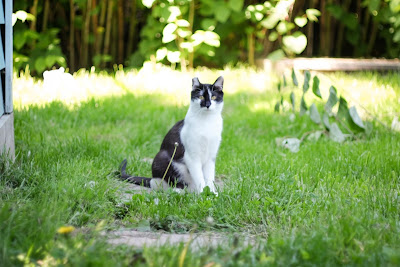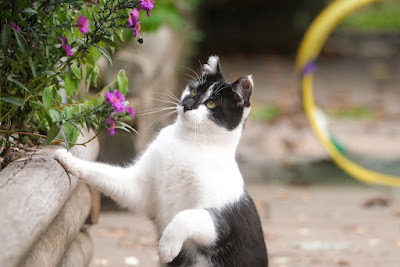 |
| Mama Moon (KN) |
Back in November, we welcomed a mother cat and her four kittens to the Sanctuary. Normally that would be No Big Deal – our Adoption Centre is kept busy with incoming feline families. But these five were a little different. They came to us from Manitoba, where they were found abandoned after their people had moved away – and fall in Manitoba is cold!
 |
| Galaxy prefers hiding (KN) |
Luckily, they were taken in by a small local rescue group with the irresistible name of
What’s One More Community in Winnipeg. This is a very small organization, doing an enormous job with limited resources – and any financial help is gratefully received. They took this little feline family into foster, and got them checked over by the vet – to receive the sad news that all of them tested positive for FeLV – feline leukemia.
 |
| Cosmo - always curious (BC) |
RAPS to the rescue – we are a unicorn among shelters in that we have facilities specifically for leukemia kitties, and we were delighted to welcome Mama Moon and her four teenagers to live with us. They bypassed the Adoption Centre and came straight to the Leukemia area, where they settled in pretty quickly.
 |
| Moon likes to know what's going on (BC) |
Mama Moon is a sweet girl with striking looks. The blue eyes and colouring indicate that there’s probably some ragdoll in her, though it doesn’t show up in her offspring. Daddy-cat, whoever he was, was probably black and longhaired, and that’s evident in all four. There’s been a little name-juggling, but they’re now settled as Cosmo and Eclipse (M) and Calisto and Galaxy (F).
 |
| Callisto is a flirt! (KN) |
All four are friendly, but Cosmo and Calisto are obviously extroverts, and Eclipse and Galaxy are much shyer. A visit to the Leukemia room will produce an immediate reaction of interest from Cosmo and Calisto, who will come to investigate and play, and enjoy being petted. Cosmo is mostly black with a white locket on his chest; he’s active and energetic, he loves attention and is occasionally a shoulder-climber. His sister Calisto has beautiful bronze eyes, and a striking set of whiskers; she’s a true tuxie, with not only the white bib but four white paws. Her facial white is just a thin white stripe.
 |
| Eclipse & Galaxy in hiding (KN) |
The more introverted pair often need to be hunted for; they’ve discovered the hiding places, though they will emerge when they feel safe. Eclipse, as his name suggests, is all black, and because he hides in dark corners, the pupils of his eyes tend to be dilated, so his eyes look as black as the rest of him. He is one who I have most often found in the “outside” of the Leukemia pen, though whether that is escaping or exploring is not clear. His sister Galaxy is another tuxedo, but her facial white is a striking blaze down her nose, rather than Calisto’s discreet line. The two of them can often be found hiding away together.
 |
| Cosmo goes exploring (KN) |
The five other cats already in the Leukemia pen are all semi-ferals (and not adoptable), but are very tolerant of the new family. Most of them live outside; Siamese
Neko is the most usual visitor to the inner room, and
Neptune and Athena come in when they think food is on offer. Like FIV cats, FeLV cats are adoptable to special people – but there are constraints. All RAPS cats are adopted out on condition that they remain indoor cats but this is especially important with leukemia cats. The virus that they carry is transmitted in fluid – mostly though cat saliva. Cats who lick each other, who share food and water, can pass the virus on. It is not transmissible to humans, and it dies quickly when it dries – but in wet form it is a danger to other cats.
 |
| Callisto has the best whiskers! (BC) |
The other thing about feline leukemia is that it affects the cat’s immune system, so that they have less resistance to other infections. We are careful about keeping everything very clean, and because many of us work with other cats who may have things like cat-colds or eye infections, we wash carefully before visiting them, and sanitize when we leave. There is no denying that FeLV cats tend to have shorter lives – but we also know that the virus may go dormant, and we’ve had leukemia cats like Ooly, who lived to be 18 years old. Anyone who’s lost a cat knows that the grief is a measure of the love – and most of us would rather have the love, despite the inevitable grief. So, to the right person, under the right conditions, adoption of the Moon family would be possible, though the youngsters would need to go at least in pairs.
 |
| Sharing the family tree - Callisto, Moon & Eclipse (BC) |
Till that happy time, they are having a good life in our Leukemia area; they are so engaging that they have a lot of attention from staff and volunteers, and are enjoying being somewhere much warmer than a cold Manitoba winter!
Blog by Brigid Coult
Photos by Brigid Coult & Karen Nicholson





































